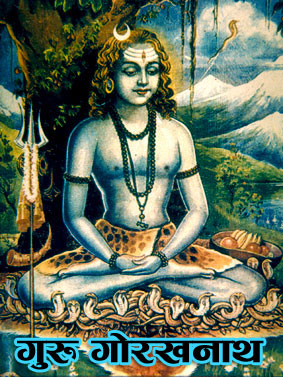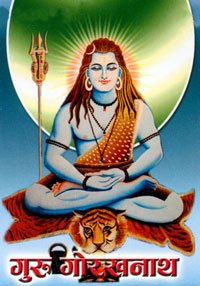|
There is no word that can describe guru Gorakh Nath and his charismatic exploits. People having achieved elemental knowledge call him Mahayogi, Mahaguru, Aadi Nath, Siddha Yogiraj, Goraksha and so on. Saints, poets, yogis, scholars and historians of all ages have sung his praise. There is no denying that all the great religions lenders work under his spiritual guidance. It is very unfortunate that only a few people of the world talk about him and pay him their respect. Guru Gorakh Nath is the supreme manifestation of supreme devinity. The shaastras tell stories in which the great trinity (Brahma, Vishnu & Maheshwor) seek his grace in times of difficulty. No one on the earth has yet been able to trace out where and how of his incarnation. Historians and research scholars have tried to construct his biography by studying and analyzing relevant materials from ancient texts, inscriptions and legends but to no avail. This centre (Siddhashram Shakti Kendra, Kathmandu) has been making efforts to collect and disseminate whatever information about the great guru and his teaching is available so that we could restore and revive the spiritual world as it was in the distant past. Guru Goraksha is accepted as the incarnation (avatar) of lord Shiva, so he is regarded as ‘inborn’, immortal, and (amusing-interesting story about the guru) which tell of events which are as old as the universe. Crake William, a western writer states that when the universe was being created, guru Gorakh Nath was deep in his tapasya behind a dhuni (eternal fire). He was in ‘patal’ (under the earth) when lord Vishnu was emerging from the great celestial lotus. And, when the great Brahma was about to create the world, he had a problem the water was dirty. He sought the help of guru Gorakh Nath, who handed him some ask from the dhuni, saying: "Sprinkle this over the water and the process of creation will start". This event shows that Brahma, Bishnu and Shiva turned to him for guidance as much as his disciples did. Gorakh- the venerable name of guru, is from the sanskrit word ‘Goraksha’ which literally means ‘protector of cows’. The word ‘go’ (cow) means many more things, some of them are : heaven; animal, vani (language), light rays, rays, disha (direction), eye, earth, water, sun, yagya, suravi (fragrance). In short the word ‘go’ means the entire universe and what ever it contains. Thus the name ‘gorakh’ means "protector of the entirety", and guru Gorakh Nath is thus recognized as the creator, controller and the protector of the universe. In Hindu religion, the cow symbolizes Laxmi ( the goddess of wealth), mother earth and the sensory organs of the body. In the cow dwell all the gods and goddess, on earth we human beings live, and by the exercise of our sensory organs we achieve both materially and spiritually. This is thus a universal system, externally protectd by the great guru Gorakh. (Gorakh Nath). There are allusions (indirect references) in Vedas and Purans to the great protective aspect of the personality of guru Gorakh Nath. The Lalitapur and Brhmanda Purans describe him as the siddha yogiraj living in perfect bliss in the world of the great winds called ‘Mahadyuti’ with divine yogi around him . In the 42nd chapter of the ‘Kedar Khanda’ part of the ‘Skanda Puran’ , lord Shiva tells his spouse Parvati that Goraksha Nath lives in ‘Gorakshya Ashram’ which is recognised as one of the holiest places. In the seven chapter of the Shiva Puran there are verses in which Brahma calls Gorakh Nath as the incarnation of lord Shiva. The ‘Goraksha Geeta’ presents an episode where Indrayani, request Brihaspati the guru of gods to go to Gorakhnath and beseech him to help bring her husband Indra back on the throne of the heavens. All these anecdotes and episodes adequately, prove the untraceable antiquity of Goraksh.
Many other ancient text tell us of yogeshwors also known as Nava Naths, who are indentified with lord Nava Narayans. Since, however, this do not mention the name of Guru Gorakh Nath in this connection it is evident that the guru was none but lord Shiva himself. Our discourse on Guru Gorakh Nath will remain incomplete if we do not include in it the story of the incarnation of guru Matsyandra Nath. The story goes like this - Lord Shiva and his spouse Uma were staying on the isle of ‘Saptashringa’ in the Ksheer Sagar’. One five day Uma beseeched the lord to educate her in ‘yoga tatwa’ But as soon as the lord started his ‘upadesh’ (the verses of ‘yoga-tatwa’), Uma fell asleep and a boy who lay in the womb of a large fish swiming about their listened to the ‘upadesh’ and got enlightened. After the boy was born, lord Shiva named him ‘Matsyandra Nath’ who late obtained divine and mystic powers. Having made up his mind to work for the welfare of the world. Matsyandra Nath took to tapasya in proximity of the lord. Lord Shiva appeared with tapasya and told him to ask for a boon. At that time he (Matsyandra Nath) entreated "Be born as my disciple lord". To fulfill Matsyandra Nath’s wish lord Shiva incarnated himself as Gorakh Nath. The lord Shiva became the disciple of Matsyandra Nath and thus started the guru-disciple tradition. In the Trivendram edition of his composition ‘Maharth Manjari’, we find Guru Gorakh Nath introduce himself like this : "the perfect Madhav is my father and the great Matsyandra Nath my teacher (guru). Those who know about me call me Gorakh Nath and those who know me call me Maheshworananda". Guru Gorakh Nath was known and worshipped through all the ages. The ancient book ‘Goraksha Stotra’ contains verses in which lord Krishna and Rukmini sing in his praise. Here is a description of an event from the ‘Dwapar yug’, which is honoured by time and tradition. Dharmaraj Yudhistir was going to perform the ‘Rajsuya yagya’. he sent his second brother Bhimsen with humble words of invitation, to Guru Gorakh Nath.When Bhimsen reached Gorakh Nath’s ashram, he found the guru deep in tapasya. Someone told him to wait untill the guru rose from his tapasya. The moment Bhimsen sat down the ground, his unusual weight forced the ground and the whole place soon turned into a pond. One can still see the pond in front of the temple of Gorakh Nath in Gorakhpur. There is an icon of Bhimsen sleeping which is worth a darshan. The ancient text Shree Nath Tirthawali mentions Gorakshpur (Gorakhpur ) as the first place of pilgrimage in the east. On the north of this holy place is the shrine of Guru Gorakh Nath. In the ‘Treta yug’, they had begged Guru Gorakh Nath to come and bless Ram during his coronation. Since however, the guru was then absorbed in tapasya and could not break it, his disciples sent ‘prasad’ of various forms of guru’s holy blessings. All the events and episodes clearly evidence that Guru Gorakh Nath is an immortal and ageless personality. Guru Gorakh had first revealed himself in Nepal. He had come out of the Gorkha cave in the Gorkha district of Nepal. Let us be and remain faithful to Guru Gorakh Nath, historically and in all other ways, and receive his compassion and blessing. Let us pay homage to him and remain devout to him. Jai Gorakh ! |
 The great
ageless Saint:-
The great
ageless Saint:-